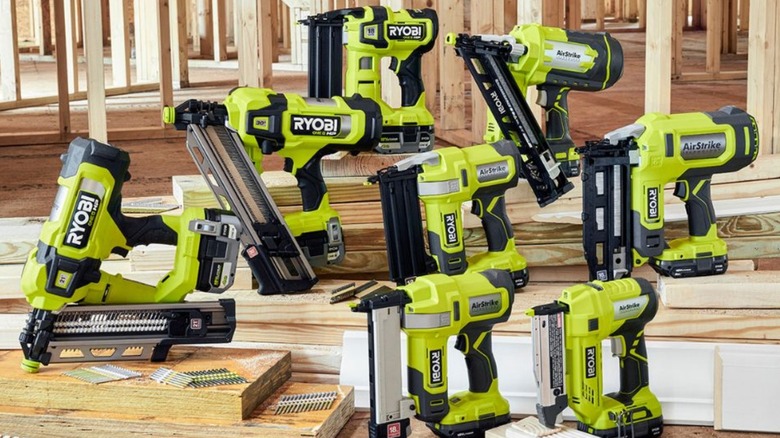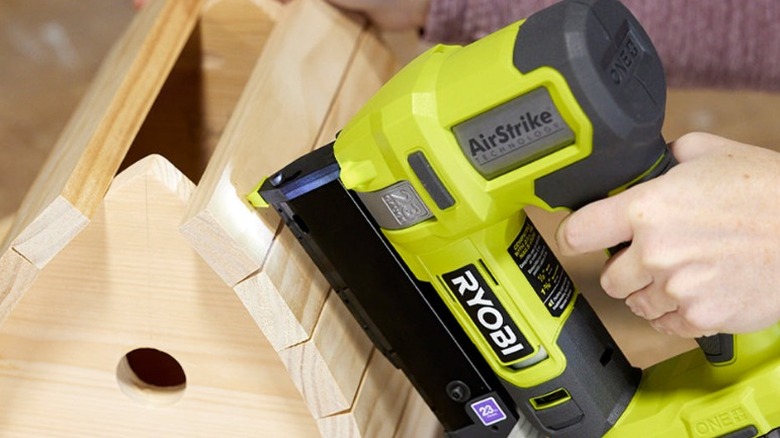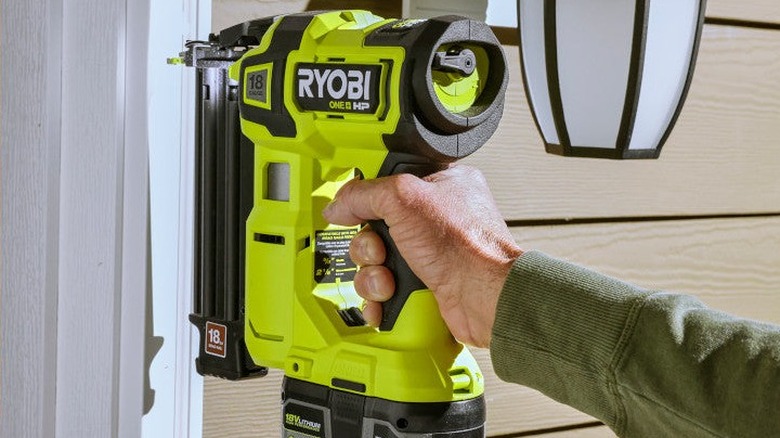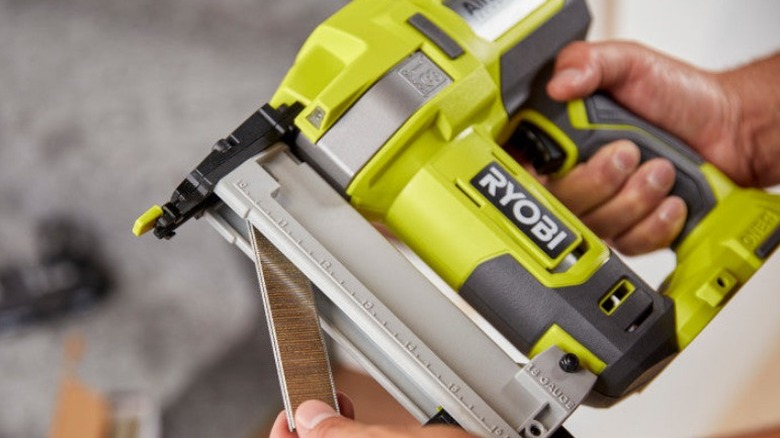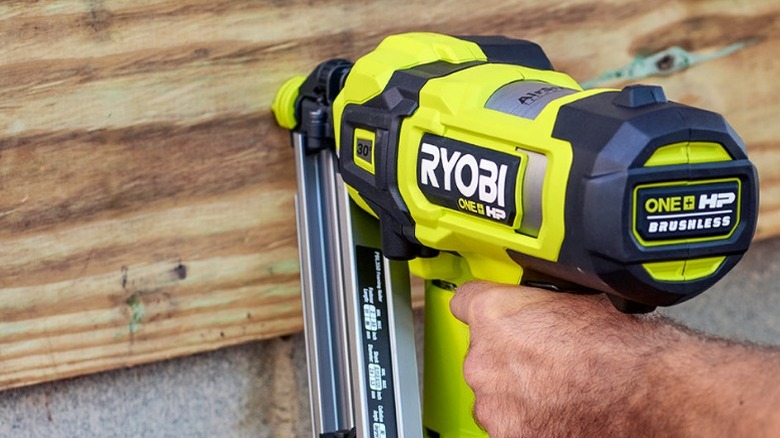Ryobi Nail Guns: How Many Types There Are & Which Is Best For You
We may receive a commission on purchases made from links.
A good nail gun can make a lot of projects much easier. Whether you're adding trim to a home, putting up a fence, or working on installing a new roof, having a tool that can shoot nails at the push of a button is a lot better than having to drive them in one by one with a hammer, and having one that's battery-powered is even easier since it negates the need for a long and awkward hose attached to an air compressor. But those who don't know much about these tools might not realize that there are several different kinds of nailers out there.
Ryobi is widely considered one of the best power tools brands on the market, and it makes a lot of different kinds of battery-powered nailers that operate using its One+ battery system. Just walk the shelves of your local Home Depot, and you'll see a wide assortment of different sizes, prices, and styles. There are currently 21 different listings for nailers and staplers on the Ryobi website (including both kits and standalone versions). That's because different nailers shoot different kinds of nails, each designed for different tasks. Many of these are measured in gauges, with the higher numbers representing thinner nails while the lower numbers represent thicker ones. There are also nails with different shapes and head types, with some designed to anchor the wood while others are meant to disappear beneath its surface. This can make purchasing a nail gun confusing, so fans of the Ryobi brand might wonder what kinds of nailers the company makes and what the differences are between the models in each category.
Pin nailers
As you might imagine from the name, pin nailers shoot very thin nails — usually 23GA. These can be used for thin trim or molding, but they're more often used in delicate craft work such as building picture frames or small jewelry boxes. Some people also use them for assembling cabinetry. Pins don't have a lot of structural integrity, so they are often used to 'pin' pieces in place while glue dries. The main appeal of them is that the holes they create are incredibly small, so they aren't very noticeable to the naked eye.
There's only one pin nailer made by Ryobi: The 18V One+ Airstrike 23GA Pin Nailer. This is sold as both a stand-alone option and as part of a kit that comes with a 2Ah battery and charger. This nail gun can drive up to 1,000 nails per charge with the battery included in the kit and up to 4,000 nails in a single charge if you upgrade to a 6Ah battery. It's able to sink nails between ½-inch and 1 ⅜-inches in length. Ryobi advertises that this is the smallest and lightest pin nailer that the company has ever produced, which makes it easy to maneuver. It has a non-marring pad for protecting work surfaces and a dry fire lockout sequence, which prevents the tool from discharging when it's out of nails.
This is a good tool to have for extremely light-duty assembly and for pinning together projects that are going to be primarily bound by glue since 23GA nails aren't much thicker than a piece of wire. You probably don't want to use a tool like this for anything where you expect the nail to bear weight or be the primary binding agent.
Brad nailers
Brand nailers typically use 18-gauge nails, making them sort of a middle ground between pins and finishing nails. These are significantly thicker than pins but still aren't ideal for load-bearing. They're often available in longer sizes and have a bit more holding power, which makes them ideal for installing all kinds of baseboards and crown molding as well as non-load-bearing furnishing work and decorative pieces.
There are two brad nailers currently being made by Ryobi, with both of them having the option for you to buy them as an individual tool or as part of a kit that includes a 4Ah battery and charger. The first is the 18V One+ Airstrike 18GA Brad Nailer, which promises the power to sink 2-inch nails into hardwoods. This tool can fire up to 1,900 nails on a single charge with a magazine that can hold up to a 105-nail capacity. It can use nails that are between ⅝"-inch and 2-inches in length. Ryobi claims that this is the lightest brad nailer in its class. The other option is the 18V One+ HP Brushless Airstrike 18GA Brad Nailer. These are actually a bit different in spite of their names and jobs being so similar. This tool can fire 2,250 nails per charge with a 105-nail capacity. It fires nails that are between ⅝-inch and 2 ⅛-inches in size.
Part of the reason why you might prefer a brad nailer to a finish nailer is that the smaller holes they produce are easier to hide with paint, and the thinner nails are less likely to cause wood to split, particularly when connecting delicate edges.
Finish nailers
Finishing nailers usually fire nails in the 15-16 gauge range. You can use them for installing door and window casings, cabinet trim, and assembling wooden furniture that will also be held together with glue.
There are currently four different finish nailers available on the Ryobi site. There are two 15GA nailers and two 16GA nailers. The 18V One+ Airstrike 15GA Angled Finish Nailer is the most affordable option. It's able to fire up to 750 nails on a single charge at a rate of 60 nails per minute. It shoots at a 34° angle and can sink nails between 1-inch and 2 ½-inches in size. The 18V One+ HP Brushless 15GA Angled Finish Nailer is significantly more expensive but offers better specs, which makes it a good option for working professionals. It can shoot up to 1,500 nails per charge with a 4Ah Performance battery and has a 114-nail capacity. It also shoots at a 34° angle and can sink nails between 1 ¼-inches and 2 ½-inches in length.
The 18V One+ Airstrike 16GA Finish Nailer shoots smaller nails than its 15GA counterpart but comes at a slightly higher price. It can sink up to 1,000 nails per charge, with a 105-nail capacity. It shoots straight and fires nails between ¾-inch and 2 ½-inches in length. Finally, the 18V One+ HP Brushless 16GA which is currently listed as 'coming soon.' It promises the ability to deliver 1,800 nails per charge with a 112-nail magazine and compatibility with 1 ¼-inch to 2 ½-inch nails.
These offer the most holding power of any sink nail, but keep in mind that they will produce a larger hole that may need to be concealed with filler prior to painting if you don't want it to show.
Staplers
Ryobi also makes a few different kinds of staple guns. While most of these aren't technically nail guns in the conventional sense, they are often placed in the same category, and some of them are able to shoot more than one type of fastener.
Ryobi makes four different kinds of power staplers. It has an 18V One+ ⅜-inch Crown Stapler that essentially has the design of your typical staple gun but is battery-powered, so you can fire it simply by pushing a button rather than having to pull back a tense lever that loads a spring. It shoots crown staples from ¼-inch to 9/16-inch in size.
Then there's the USB Lithium 4-in-1 craft stapler/nailer, which is very similar except that it runs on an included USB battery system and it shoots multiple types of fasteners including heavy-duty staples (1/4" – 9/16"), round crown staples (3/8" – 9/16") and brad nails (5/8"). This isn't as powerful as a dedicated nailing tool with one of the company's more potent One+ batteries, but it promises "over 600 staples/nails" per charge which makes it a good, affordable, all-around solution for light duty nailing and stapling needs. The other two crown staplers are a bit more heavy-duty.
The 18V One+ Airstrike Narrow Crown Stapler is sold individually or as part of a kit that includes a 1.5Ah battery and a charger. It can fire up to 1,700 staples per charge, can sink 1 ½-inch staples into hardwood, and fits staples between ⅜-inch and 1 ½-inches in length. Meanwhile, the 18V One+ HP Brushless 18GA Narrow Crown Stapler, which is marked as 'coming soon,' promises up to 1,900 staples per charge, a 105-staple capacity, and the ability to shoot staples ⅜-inch to 1 ½-inches in length.
Framing nailers
Finally, we have framing nailers. These are the real heavy-duty models that are actually able to shoot nails with the structural capacity to hold together heavy objects. These are often used for constructing wall frames, building decks, and putting up fences. They can also be used for putting in subflooring and roof sheathing.
Ryobi currently makes two different framing nailers that are each available individually or as part of a kit that includes a 4Ah High Performance battery and a charger. The 18V One+ HP Brushless Airstrike 21° Framing Nailer is able to fire up to 750 rounds on a single charge and has a 33-nail capacity. It can shoot full round head nails that are between 2 inches and 3 ½-inches in length. The other option is the 18V One+ HP Brushless Airstrike 30° Nailer. This can also shoot up to 750 nails on a single charge, but it has a much larger 60-nail capacity, and it can use both clipped and full head nails that are between 2 inches and 3 ½ inches.
The different angles offered by framing nailers have different strengths. A 21° nailer uses full round head nails, which ensure a stronger hold. The angle makes it a solid choice for those who need to work in tight spaces. A 30° nailer, on the other hand, is more dynamic in that it can hold both full round and clipped round heads. Their larger capacities also mean they need to be reloaded less frequently.
